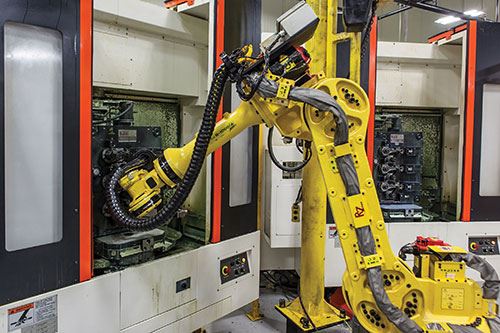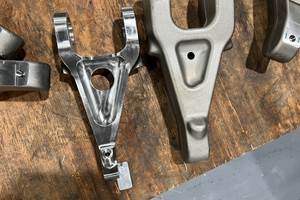Automated HMC Cell Powers Rod Production Flexibility
To quickly change rod connector types, automotive manufacturer Metaldyne installed a fully automated HMC cell of standalone Mazak HMCs and a FANUC robot.
Share





A fast, flexible and cost-effective manufacturing environment is necessary to produce components at the rapid rate the automotive industry requires. That’s why connecting rod manufacturer Metaldyne decided to move from conventional, dedicated line equipment to a fully automated, high-production cell of Mazak machines. The cell’s flexibility enables the manufacturer to produce a variety of rod styles to keep pace with new engine and rod designs, and even take on work that other manufacturers were hesitant to consider.
Metaldyne’s 180-person plant in North Vernon, Ind., pumps out high volumes of fracture-split and powder-metal-forged connecting rods, said to enhance engine performance compared with conventional drop-forged rods. Although the newer, advanced material powder mixes make the rods more machining friendly during the cutting process, producing connecting rods can take its toll on machines, especially in 24/7 high-production environments.
Most of Metaldyne’s connecting rods feature what are known as trapezoidal (TP) ends. These 6-, 10- or 12-degree angles are machined on both sides of the connecting rod pin ends, where pistons mount to the rods. They reduce weight and create additional clearance so that auto-makers can use pistons with bigger pins, as is the case with smaller, high-compression, direct-gas, turbo-type engines that produce greater horsepower and consume less fuel.
As demand for these types of engines increased, so too did Metaldyne’s orders for connecting rods with TP ends. According to Greg Cunningham, Metaldyne process engineer, the first TP-end order was a substantial one from a major automotive customer. To accommodate this work, the plant earmarked it for existing dedicated systems, which as it turns out, put the machines at full capacity.
“We were at full output with our specialized machines, and on top of that, the lead time for the second project was extremely tight. There was no time to install another dedicated system,” Mr. Cunningham says.
Instead of waiting a year or more for another specialized machine, Metaldyne worked with machine tool builder Mazak Corp. (Florence, Ky.) and its distributor Shelton Machinery in Fishers, Ind., to install an automated high-production cell composed of two identical Mazak Horizontal Center Nexus (HCN) 400-II machining centers and a standalone FANUC robot. Mazak delivered the two horizontal machining centers (HMCs) within four months.
“This short delivery time, along with machine capability and flexibility, definitely influenced our decision to go with Mazak, as did the fact that the company is close by,” Mr. Cunningham says.
Each HMC delivers a rapid traverse speed ranging to 2,362 ipm at a 0.8-G acceleration rate. The NC rotary tables rotate 90 degrees in 1.5 seconds and feature 0.001-degree minimum step for precise four-axis indexing and machining. In addition to two-pallet changing capability, each machine provides X-, Y- and Z-axis travel, measuring 22.1, 24.8 and 25.2 inches, respectively. Additionally, the machines provide the repeatability and precision necessary for the company to easily attain its connecting rod tolerance requirements, which can be as tight as 0.0002 inch.
According to Mr. Cunningham, the HCN 400-IIs possess the speed, power and rigidity necessary to stand up to the rigors of nearly non-stop powder metal rod machining. Metaldyne can also change rod types in just a few hours with the HMCs, as opposed to the several days its dedicated equipment requires. Another benefit of the automated cell is that it can be used if the plant’s dedicated equipment ever goes down or if there is a production pinch.
“Mazak really understood our manufacturing goals and objectives,” Mr. Cunningham says. “Instead of just bringing in a machine and setting it up, Mazak understood exactly what we wanted to achieve and engineered a complete cell to accomplish that.”
For instance, Mazak and Shelton engineers worked with Metaldyne to ensure the fixturing provided secure part holding and that change-overs were as fast and easy as possible, Mr. Cunningham says. They also proved out the automation prior to installation.
Additionally, Mazak did the programming so that Metaldyne could have a complete turnkey system. Mr. Cunningham says the Matrix Nexus CNCs are user-friendly, though, so it’s easy for Metaldyne to edit programming on occasion.
Perhaps most beneficial, the cell allows the plant to cost effectively take on lower-volume programs, such as those requiring only half a million or so rods per year, and even prototypes. Other connecting rod manufacturers with dedicated lines are often hesitant to quote low-volume jobs because of the costly change-overs and retooling involved.
Within the cell, the Mazak HMCs are set at inward angles so the one robot can load/unload both of the machines. The cell runs completely unattended, although one person does quality control, periodically checking to make sure parts are feeding correctly and that there are no alarms caused by a part seated incorrectly in a fixture. On the machine pallets, tombstone workholding equipped with hydraulically actuated fixturing secures the rods, enabling machining of both TP-end sides.
The HCN 4000-IIs complete TP angles in a single, straight Z-axis-plunge cut using one of three different size inserted cutters—depending on rod size. The machines carry a lot of redundant tooling as well as sets of tooling specifically for each rod size that runs through the cell. This 4-second, single-plunge operation can remove as much as 0.180 inch of material for a 6-degree angle and as much as 0.360 inch for a 12-degree angle. Cutters plunge to these full required angle depths. The Mazak machines can complete TP ends on six rods every 56 seconds, outperforming Metaldyne’s dedicated equipment with gantry loaders.
With the cell’s increased speed and the flexibility to cost-effectively change rod types, Mr. Cunningham foresees continued growth for Metaldyne. Smaller-engine platforms and the plant’s special ability to machine and offer high-strength, lighter-weight rods from advanced powder metals will be catalysts for increased business, he says.
Related Content
Shop “Dims the Lights” With Pallets and More
Adding pallet systems brought Mach Machine success and additional productivity. The shop has since furthered its automation goals while adding new capabilities.
Read MoreLean Approach to Automated Machine Tending Delivers Quicker Paths to Success
Almost any shop can automate at least some of its production, even in low-volume, high-mix applications. The key to getting started is finding the simplest solutions that fit your requirements. It helps to work with an automation partner that understands your needs.
Read MoreHorizontal High-Speed Machining Saves Hundreds of Work Hours
High-speed machining is the latest change at Blair-HSM South, helping this once old-fashioned shop improve productivity and morale while enabling new work.
Read MoreGrob Robot Cell Enables Long Periods of Unmanned Operation
The GRC-R12 robot cell features a pneumatic single- or double-gripper system, as well as a drawer feed system with six drawers.
Read MoreRead Next
Building Out a Foundation for Student Machinists
Autodesk and Haas have teamed up to produce an introductory course for students that covers the basics of CAD, CAM and CNC while providing them with a portfolio part.
Read More5 Rules of Thumb for Buying CNC Machine Tools
Use these tips to carefully plan your machine tool purchases and to avoid regretting your decision later.
Read MoreSetting Up the Building Blocks for a Digital Factory
Woodward Inc. spent over a year developing an API to connect machines to its digital factory. Caron Engineering’s MiConnect has cut most of this process while also granting the shop greater access to machine information.
Read More




































